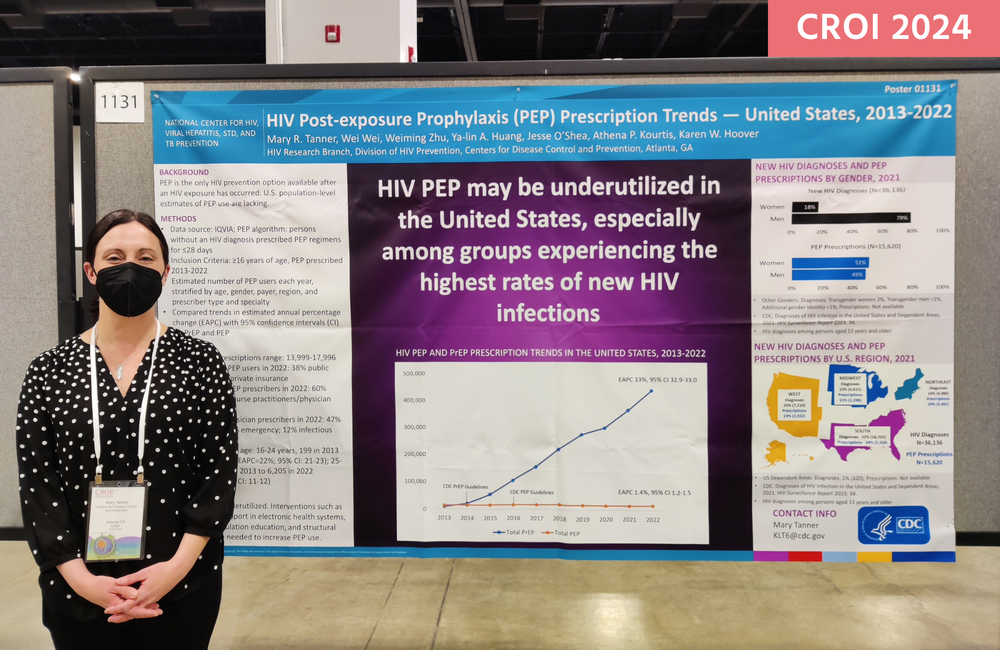
Services providing post-exposure prophylaxis (PEP) and pre-exposure prophylaxis (PrEP) need to build stronger connections between these two ways of preventing HIV infection, so as to help people who’ve used one method to access the other, according to experts at the Conference on Retroviruses and Opportunistic Infections (CROI 2024).
While the overall numbers of people seeking PEP remain limited, in recent years many of those accessing it have previously been prescribed PrEP. But for one reason or another, they didn’t use it consistently, and now feel the need for an emergency measure. At the same time, many people currently prescribed PEP are likely to need protection again in the coming weeks and months.
Dr Mary Tanner of the Centers for Disease Control and Prevention (CDC) pointed to a disconnect between PEP and PrEP in the United States. During PrEP’s first decade (from 2013), uptake grew steadily from zero to around 450,000 in 2022.
Over the same time period, usage of PEP – the older method – barely changed. Each year there were between around 14,000 and 18,000 PEP prescriptions. Averaged out, usage increased by just 1.3% a year. In contrast, PrEP usage increased by 33% each year.
As well as being under-used, PEP isn’t necessarily used by those in the greatest need. Whereas four in five new HIV diagnoses are in men, only half of PEP prescriptions are for men. While over half of new HIV diagnoses occur in the south of the country, only a third of PEP prescriptions are issued there.
Dr Tanner told aidsmap that stronger connections between PEP and PrEP services are needed. PEP and PrEP are on the same continuum, and people using one of them need to know about the other. But separate guidelines are issued for each prevention method, and they do not emphasise linkages between them.
Guidelines in the United Kingdom recommend a smooth transition from PEP to PrEP, and Dr Gary Whitlock of 56 Dean Street reported on his clinic’s work to ensure that the recommendation is followed. This London sexual health clinic provides a quarter of all PEP prescriptions and a third of all PrEP prescriptions in England.
Since January 2021, everyone receiving PEP is offered a one-month supply of PrEP, to be started when they complete the 28-day course. This is provided on an ‘opt out’ basis – in other words it is only not provided if the person says they do not want it.
In March and April 2022, 56 Dean Street provided PEP to 282 gay and bisexual men and six transgender women. (Other demographic groups were not included in this analysis.) Half were between the ages of 25 and 37, over half were born overseas, and 63% were White.
For 58%, this wasn’t the first time they had attended Dean Street, and 44% had used PrEP before. The most common reason for their sex not having been covered by PrEP were not having a PrEP supply at the time, perhaps due to difficulties accessing the clinic or other barriers (30%); having chosen to take a break from PrEP (25%); spontaneous sex (15%); and having taken the wrong dose (13%).
Three-quarters of people prescribed PEP (212) accepted the offer of PrEP, and over half (114) later came back to 56 Dean Street for a PrEP appointment. PEP users who subsequently started PrEP were more likely to have previously used PrEP and attended 56 Dean Street, and were more likely to have had multiple sexual partners on the occasion they sought PEP for. Whitlock said that offering PrEP opens the door to a wider discussion about HIV prevention options, including checking that former or current PrEP users understand the best way to use it.
Some conference delegates had concerns about the possibility of an HIV seroconversion being missed by testing if people switch immediately from PEP to PrEP. Exposure to antiretrovirals can suppress the production of antibodies, which very occasionally means that a point-of-care test misses an infection. Having a gap between PEP and PrEP might avoid this very low risk, but would also miss the opportunity of providing ongoing protection to people with a demonstrated need for HIV prevention.
Tanner MR et al. HIV Post-Exposure Prophylaxis Prescription Trends: United States, 2013-2022. 31st Conference on Retroviruses and Opportunistic Infections, Denver, abstract 1131, 2024.
View the abstract on the conference website.
Whitlock GG et al. PEP2PrEP: an effective HIV risk-reduction strategy. 31st Conference on Retroviruses and Opportunistic Infections, Denver, abstract 1133, 2024.
